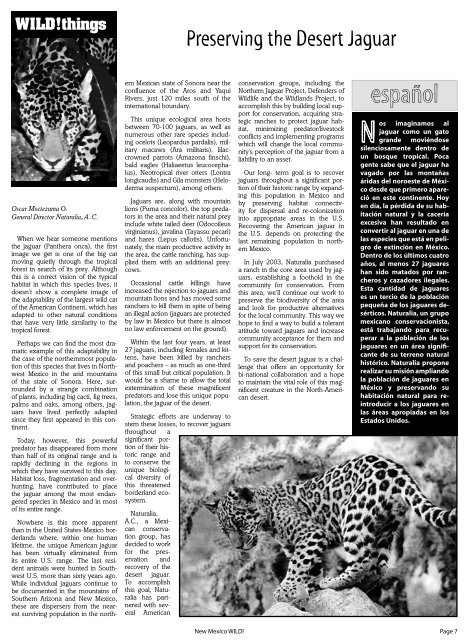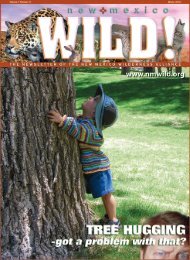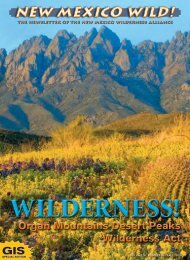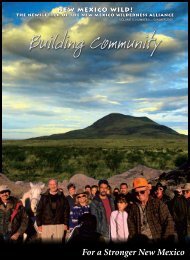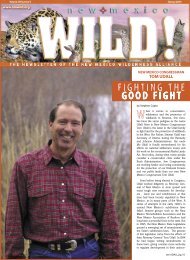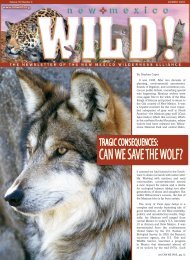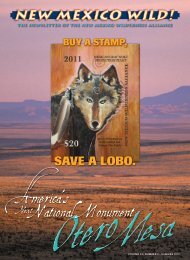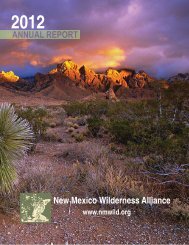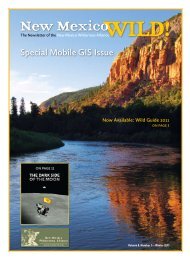WildernessProtection - New Mexico Wilderness Alliance
WildernessProtection - New Mexico Wilderness Alliance
WildernessProtection - New Mexico Wilderness Alliance
- No tags were found...
Create successful ePaper yourself
Turn your PDF publications into a flip-book with our unique Google optimized e-Paper software.
Preserving the Desert JaguarOscar Moctezuma O.General Director Naturalia, A.C.When we hear someone mentionsthe jaguar (Panthera onca), the firstimage we get is one of the big catmoving quietly through the tropicalforest in search of its prey. Althoughthis is a correct vision of the typicalhabitat in which this species lives, itdoesn’t show a complete image ofthe adaptability of the largest wild catof the American Continent, which hasadapted to other natural conditionsthat have very little similarity to thetropical forest.Perhaps we can find the most dramaticexample of this adaptability inthe case of the northernmost populationof this species that lives in Northwest<strong>Mexico</strong> in the arid mountainsof the state of Sonora. Here, surroundedby a strange combinationof plants, including big cacti, fig trees,palms and oaks, among others, jaguarshave lived perfectly adaptedsince they first appeared in this continent.Today, however, this powerfulpredator has disappeared from morethan half of its original range and israpidly declining in the regions inwhich they have survived to this day.Habitat loss, fragmentation and overhunting,have contributed to placethe jaguar among the most endangeredspecies in <strong>Mexico</strong> and in mostof its entire range.Nowhere is this more apparentthan in the United States-<strong>Mexico</strong> borderlandswhere, within one humanlifetime, the unique American jaguarhas been virtually eliminated fromits entire U.S. range. The last residentanimals were hunted in SouthwestU.S. more than sixty years ago.While individual jaguars continue tobe documented in the mountains ofSouthern Arizona and <strong>New</strong> <strong>Mexico</strong>,these are dispersers from the nearestsurviving population in the northernMexican state of Sonora near theconfluence of the Aros and YaquiRivers, just 120 miles south of theinternational boundary.This unique ecological area hostsbetween 70-100 jaguars, as well asnumerous other rare species includingocelots (Leopardus pardalis), militarymacaws (Ara militaris), lilaccrownedparrots (Amazona finschi),bald eagles (Haliaeetus leucocephalus),Neotropical river otters (Lontralongicaudis) and Gila monsters (Helodermasuspectum), among others.Jaguars are, along with mountainlions (Puma concolor), the top predatorsin the area and their natural preyinclude white tailed deer (Odocoileusvirginianus), javalina (Tayassu pecari)and hares (Lepus callotis). Unfortunately,the main productive activity inthe area, the cattle ranching, has suppliedthem with an additional prey:cows.Occasional cattle killings haveincreased the rejection to jaguars andmountain lions and has moved someranchers to kill them in spite of beingan illegal action (jaguars are protectedby law in <strong>Mexico</strong> but there is almostno law enforcement on the ground).Within the last four years, at least27 jaguars, including females and kittens,have been killed by ranchersand poachers – as much as one-thirdof this small but critical population. Itwould be a shame to allow the totalextermination of these magnificentpredators and lose this unique population,the jaguar of the desert.Strategic efforts are underway tostem these losses, to recover jaguarsthroughout asignificant portionof their historicrange andto conserve theunique biologicaldiversity ofthis threatenedborderland ecosystem.Naturalia,A.C., a Mexicanconservationgroup, hasdecided to workfor the preservationandrecovery of thedesert jaguar.To accomplishthis goal, Naturaliahas partneredwith severalAmericanconservation groups, including theNorthern Jaguar Project, Defenders ofWildlife and the Wildlands Project, toaccomplish this by building local supportfor conservation, acquiring strategicranches to protect jaguar habitat,minimizing predator/livestockconflicts and implementing programswhich will change the local community’sperception of the jaguar from aliability to an asset.Our long- term goal is to recoverjaguars throughout a significant portionof their historic range by expandingthis population in <strong>Mexico</strong> andby preserving habitat connectivityfor dispersal and re-colonizationinto appropriate areas in the U.S.Recovering the American jaguar inthe U.S. depends on protecting thelast remaining population in northern<strong>Mexico</strong>.In July 2003, Naturalia purchaseda ranch in the core area used by jaguars,establishing a foothold in thecommunity for conservation. Fromthis area, we’ll continue our work topreserve the biodiversity of the areaand look for productive alternativesfor the local community. This way wehope to find a way to build a tolerantattitude toward jaguars and increasecommunity acceptance for them andsupport for its conservation.To save the desert jaguar is a challengethat offers an opportunity forbi-national collaboration and a hopeto maintain the vital role of this magnificentcreature in the North-Americandesert.españolNos imaginamos aljaguar como un gatogrande moviéndosesilenciosamente dentro deun bosque tropical. Pocagente sabe que el jaguar havagado por las montañasáridas del noroeste de Méxicodesde que primero aparecióen este continente. Hoyen día, la pérdida de su habitaciónnatural y la caceríaexcesiva han resultado enconvertir al jaguar en una delas especies que está en peligrode extinción en México.Dentro de los últimos cuatroaños, al menos 27 jaguareshan sido matados por rancherosy cazadores ilegales.Esta cantidad de jaguareses un tercio de la poblaciónpequeña de los jaguares desérticos.Naturalia, un grupomexicano conservacionista,está trabajando para recuperara la población de losjaguares en un área significantede su terreno naturalhistórico. Naturalia proponerealizar su misión ampliandola población de jaguares enMéxico y preservando suhabitación natural para reintroducira los jaguares enlas áreas apropiadas en losEstados Unidos.<strong>New</strong> <strong>Mexico</strong> WILD!Page 7


